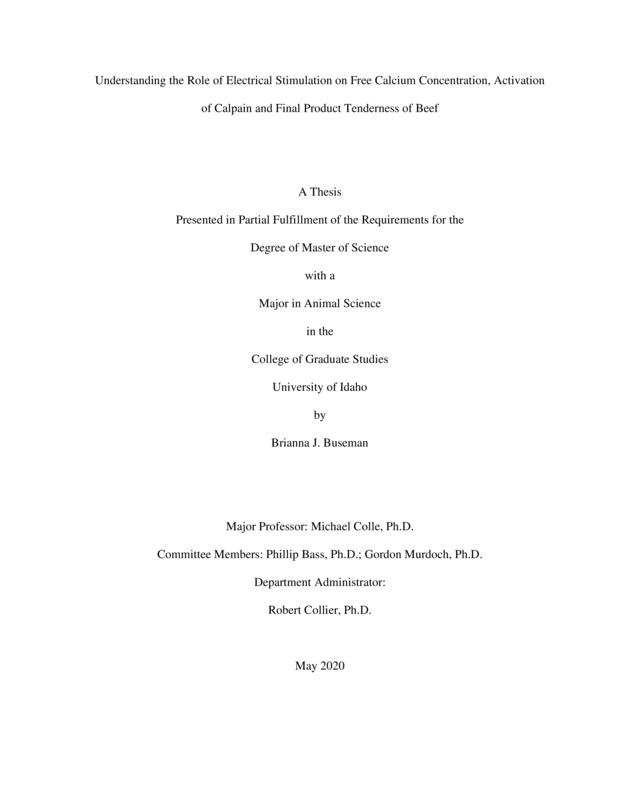Understanding the Role of Electrical Stimulation on Free Calcium Concentration, Activation of Calpain, and Final Product Tenderness of Beef
Buseman, Brianna. (2020-05). Understanding the Role of Electrical Stimulation on Free Calcium Concentration, Activation of Calpain, and Final Product Tenderness of Beef. Theses and Dissertations Collection, University of Idaho Library Digital Collections. https://www.lib.uidaho.edu/digital/etd/items/buseman_idaho_0089n_11824.html
- Title:
- Understanding the Role of Electrical Stimulation on Free Calcium Concentration, Activation of Calpain, and Final Product Tenderness of Beef
- Author:
- Buseman, Brianna
- Date:
- 2020-05
- Embargo Remove Date:
- 2022-08-26
- Keywords:
- Beef Calpain Electrical Stimulation Tenderness
- Program:
- Animal and Veterinary Science
- Subject Category:
- Animal sciences
- Abstract:
-
Consumers report tenderness to be the most important palatability trait when consuming meat. Calpains are calcium activated proteases that are considered the primary proteolytic system involved in postmortem protein degradation, leading to improved tenderness. Calpain-1 is activated early postmortem while calpain-2 is activated after several days or even weeks postmortem. Activating calpain-2 earlier postmortem has the potential to improve tenderness after fewer days of aging. The objectives of this thesis are to 1) determine the effect of electrical stimulation on free calcium concentration, calpain activity and final product tenderness of the longissimus lumborum (LL) and semimembranosus (SM) and 2) introduce the unidentified 3rd band of calpain analyzed in this project. Twenty-three beef steers were harvested and stimulated (S) or not stimulated (NS) at exsanguination and at 1-hour postmortem, resulting in four stimulation treatments: NS-NS, NS-S, S-NS, or S-S. Overall, stimulation treatment was not shown to influence native calpain-1 or -2 activity, autolyzed calpain-2 activity, WBSF, or consumer sensory analysis in the LL. It did, however, impact autolyzed calpain-1 activity. In the SM, stimulation treatment did not influence free calcium concentration, calpain activity, WBSF or consumer sensory scores. Interestingly, during the analysis, an unidentified 3rd band of calpain was observed in many samples. Stimulation treatment was not significant in determining whether the 3rd band of calpain was observed. Analysis was conducted by the University of Idaho Mass Spectrometry Core Lab to classify the unidentified 3rd band using Liquid Chromatography-Mass Spectrometry (LC-MS), with little success. Further analysis needs to be conducted to characterize the unidentified 3rd band and determine its relation to calpain-1, if any. In the present study, stimulation treatment did not significantly improve free calcium concentration, overall calpain activity, or final product tenderness. Other interventions need to be studied to activate calpain activity earlier postmortem and improve final product tenderness.
- Description:
- masters, M.S., Animal and Veterinary Science -- University of Idaho - College of Graduate Studies, 2020-05
- Major Professor:
- Colle, Michael
- Committee:
- Bass, Phillip; Murdoch, Gordon
- Defense Date:
- 2020-05
- Identifier:
- Buseman_idaho_0089N_11824
- Type:
- Text
- Format Original:
- Format:
- application/pdf
- Rights:
- In Copyright - Educational Use Permitted. For more information, please contact University of Idaho Library Special Collections and Archives Department at libspec@uidaho.edu.
- Standardized Rights:
- http://rightsstatements.org/vocab/InC-EDU/1.0/

